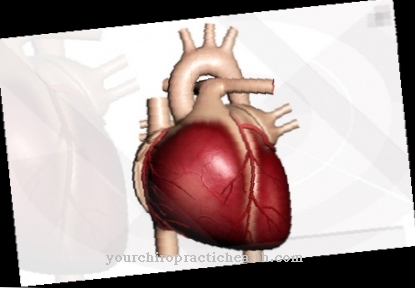The perception of humans is composed of exteroception and interoception. In addition to the sense of sight, hearing, touch, smell and taste, medicine also knows the sense of temperature, the sensation of pain and the sense of balance. Perceptions form the basis of every human action and motivation to act.
What is the perception?

People perceive stimuli from their environment as well as stimuli from their own body. The term exteroception applies to the perception of environmental stimuli. Stimuli from one's own body fall under the term interoception, which is further classified in proprioception in the sense of the perception of body positions and movements and in visceroception in the sense of the perception of organ activities.
Medicine summarizes all sensory impressions of intero and exteroception under the term of perception (partly also sensory). The senses of sight, hearing, touch, smell and taste are known to form the five systems of human perception. Modern medicine knows four other senses: the sense of temperature and the sensation of pain as part of the sense of touch, the sense of balance as part of the sense of hearing and the deep sensitivity as part of the body sensation.
The sense of temperature is known as thermal reception, the sensation of pain as nociception, the sense of balance as the vestibular sense and the body sensation as proprioception. All perception systems work with the help of so-called receptors, which bind to stimulus molecules, generate an action potential and thus translate the stimulus into the language of the central nervous system. There are different receptors per sense, all of which are specialized in certain stimuli.
The human senses work closely together and hand over to humans sensory integration of the individual perceptions an impression of his environment and the processes in his own body. The sensory integration and the interpretation of percepts take place in the brain.
Not all sensory impressions, but only the perceptual information found to be important reach the consciousness. Each sense has its own memory. New sensory impressions are compared with the schemes of memory in order to enable the fastest possible perception.
Function & task
Human perception takes place in a so-called chain of perception. This model is based on the comparison of the perceptual apparatus and the outside world. The six links in the chain each influence the next link and are involved in every sensory perception in the same order. The sixth link in the chain goes back to the first link.
At the beginning of the perception there is the stimulus. The signals generated from the outside or inside world are also known as distal stimuli. These are physical quantities. The distal stimulus binds to the sensory cells or receptor cells and interacts with them. In this way, the distal stimulus becomes a proximal stimulus.
Sensory cells transform energy such as light, pressure or sound into a voltage change. This process is called transduction and aims to generate a receptor potential.The sensory cell itself or after synaptic transmission to another nerve cell encodes receptor potentials into action potentials. Primary sensory cells do the transcoding themselves. Secondary sensory cells, like those of the retina, do not develop action potentials independently. A preprocessing of the percepts takes place in the sense organ. However, the actual processing of the sensory information takes place in the core areas of the brain.
Processing includes filtering, inhibition, convergence, divergence, integration and the summation to form a total sensory impression. The processing is followed by the awareness of the percept. This process corresponds to cognition. In cognition, sound becomes tones or noises, for example. Electromagnetic radiation turns into light.
After becoming conscious, the brain falls back on the stored memories of the respective sensory field. Only processes such as remembering, combining, recognizing, associating or interpreting and judging give people an understanding of what is perceived.
Every perception, as the sixth link in the chain, aims at a stimulus reaction. So the result of a perception is always the reaction to the percept. Many reactions aim to improve the next iteration of the chain of perception. For example, eye movements help to make new environmental properties accessible to our perception.
Perception is veridical and is based on a causal relationship between a stimulus and the stimulus representation in the brain. The chain of perception plays a decisive role in the motivation to act. Every human action is a response to stimuli from the environment or one's own body. Without sensors, people would ultimately not act at all.
You can find your medication here
➔ Medicines for visual disturbances and eye problemsIllnesses & ailments
If a link in the chain of perception is affected by disturbances, stimulus and perception can contradict one another. In this case we are talking about disturbed perception. If the result of perception processes does not correspond to reality, but the perception chain works undisturbed, then there is a perception illusion. The result is inappropriate reactions to the environment.
Perceptual disorders and delusions can be purely psychosomatic. But they can also have a physical cause. The most important physical causes include neurological diseases that are associated with lesions in the nervous tissue involved in perception. Both the signal-conducting afferent nerve pathways for transporting the perception into the central nervous system and the brain regions that are centrally involved in perception can be affected by disturbances.
For example, after strokes, spinal cord infarctions or incidents such as multiple sclerosis attacks, patients are often no longer able to perceive warm or cold sensations on the skin. The same can be the case after traumatic injuries to the central nervous system.
Perceptual disorders can just as easily be receptor disorders as they can be caused by poisoning, for example. In addition, sensory organs such as the eyes, ears or the nose and tongue can also lose their functions regardless of neural findings, for example in the event of blindness due to injuries.
Perceptual disorders can also be caused by toxic substances. For example, drug and alcohol consumption are associated with impaired consciousness. Above all, drug abuse can change the ability to perceive even in the long term.





.jpg)






.jpg)



.jpg)










.jpg)
